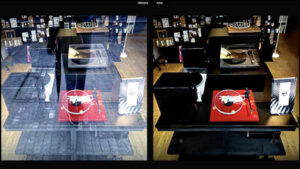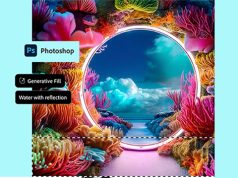
Los Angeles, CA—At Adobe MAX, Adobe Project Stardust was unveiled. The new object-aware editing engine uses generative AI (artificial intelligence) to raise the bar on image editing. Moreover, Adobe’s latest collection of early-stage innovations highlighted new uses of generative AI and 3D technologies across multiple creative domains—photo, video, audio, 3D, design as well as fashion applications.
Further, the 11 inventions were featured in Adobe’s annual “Sneaks” showcase. This is where Adobe engineers and research scientists offer first looks or “sneak peeks” at prototype ideas and technologies. Each have the potential to integrate as important elements in Adobe products.
“Adobe Sneaks are a can’t-miss, fan-favorite moment at MAX every year. And for good reason. Nothing is more inspiring than brilliant employees demonstrating cutting-edge technologies that might power future Adobe products,” said Gavin Miller, vice president and fellow of Adobe Research. “Our passion for creators is at the heart of each Sneak, and this year’s showcase highlights exciting new ways generative AI and 3D technologies can supercharge creative expression.”
Adobe Project Stardust
Project Stardust enables users to select, edit and even delete complex elements in any image. Its goal is to make image editing more intuitive, accessible and time efficient for any user. Moreover, with Adobe Firefly, Adobe’s creative generative AI models, the scope of new applications continues to scale beyond image generation.

This new class of Sneaks offers examples of how generative AI can reimagine video, audio, animation as well as motion graphics workflows. They offer the potential to cut postproduction time from days to minutes. Following are Sneaks involving various creative applications.
Photo
Project Stardust is a new object-aware editor for images that “magically” moves or removes objects by clicking on them. With Project Stardust, for example, you can select persons in a photograph, move them to a different place in the composition and fill in the background where they were previously standing. You can also change elements like the color of a person’s clothing or the position in which they’re standing. It treats any flat images like a file with layers.
Project See Through is an AI-powered tool developed to make it simple to remove reflections from photos. Glass reflections are an annoyance that everyone is familiar with in photos. They can obscure the subject of the image as well as make it unusable. Though it’s difficult if not impossible to remove reflections using existing software, See Through dramatically simplifies the process.

Video & Audio
Project Fast Fill brings the power of Firefly generative AI to video for the first time. Leveraging Generative Fill technology, Project Fast Fill offers an early look at what human-prompted generative AI could enable inside Adobe video-editing tools. These tools include Premiere Pro as well as After Effects. Adobe Photoshop already uses Generative Fill tech to ease the addition, removal or expansion of content in images with simple Firefly text prompts.
Project Dub Dub Dub automates the video-dubbing process. Thus, it makes a historically labor- and cost-intensive process as easy as clicking a button. Thanks to its AI capabilities, a video recording or audio track can be automatically translated to all supported languages. Additionally, the voice of the original speaker is preserved. It’s temporally aligned with the original dialogue and ready to publish.
Project Scene Change also makes it easy for video editors to composite a subject and scene, from two separate videos captured with different camera trajectories, into a scene with synchronized camera motion.
Project Res Up is a tool that converts video from low to high resolution. Furthermore, it does so using new diffusion-based upsampling technology.
3D & Design
Project Poseable presents a breakthrough in AI-based image-generation models. It seeks to make it easier for the image generator to interact with large 3D objects. This includes poses from photos of real people. The prototype is integrated with Project Poseable, which creates a 3D rendering from text input, taking depth and perspective into consideration, and realigns the object. While creating 3D scenes with traditional skeletal systems is technically complex and time-consuming, Project Poseable offers a more effortless alternative.

Project Neo enables creators to incorporate 3D shapes in their 2D designs. They can do so without technical expertise in 3D creation tools. Today, creators of 2D designs such as infographics, posters or logos are often limited in their ability to incorporate 3D elements. That’s because of the complexity of those workflows, which can require years of experience. Project Neo enables creators to embrace simplified 3D design within 2D tools and methods.
Project Primrose blurs the line between technology and fashion. It demonstrates the potential for flexible textile displays and turns clothes into creative canvases. The interactive dress can display content created with Adobe Firefly, After Effects, Stock as well as Illustrator.
Project Glyph Ease makes customized lettering more accessible. It streamlines the tedious design process of glyphs—the specific design and shape elements of each letter character. Beginning with a hand-drawn letter shape, Project Glyph Ease uses AI to automatically generate an entire set of glyphs matching the input lettering style. You can then edit the generated glyphs in Illustrator.
Project Draw & Delight offers a suite of generative AI tools that helps anyone along their creation journey. It can transform initial ideas—often represented as rough doodles or scribbles—into polished and refined sketches. You can then experiment with color palettes, style variations and different backgrounds.
Watch the full Sneaks session here.
Adobe MAX
The Adobe MAX creativity event offered something for creators at all skill levels, working across all forms of media. It ran from October 10–12. The three-day conference in Los Angeles was packed with creative luminaries, musical performances and global, collaborative art projects as well as networking.
Speakers such as actor Adam Devine; record producer, songwriter and entrepreneur Oak Felder; creative director Karen X Cheng; DDC founder Aaron Draplin; and cofounder/creative director Walker Noble shared insights into their creative processes. Adobe MAX also showcased how Adobe is using Firefly with Creative Cloud, Express and Experience Cloud to power a world-class event experience.





